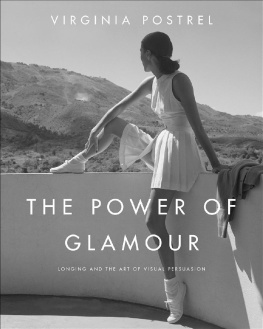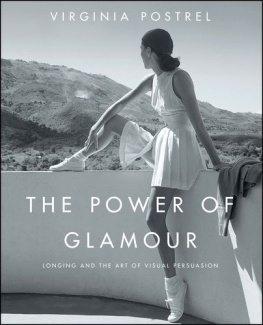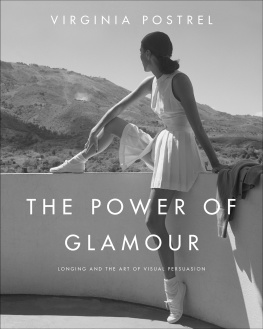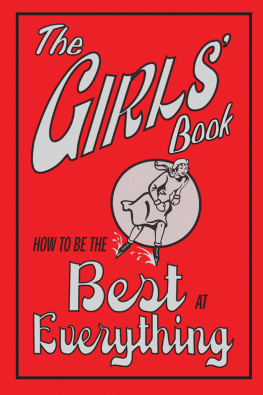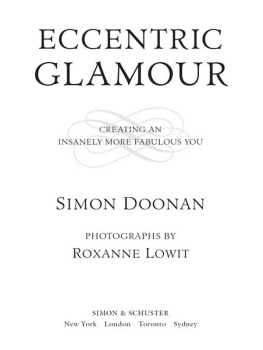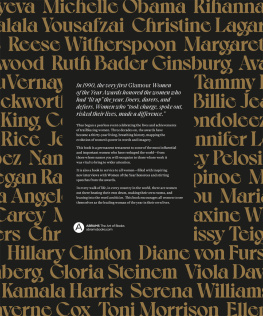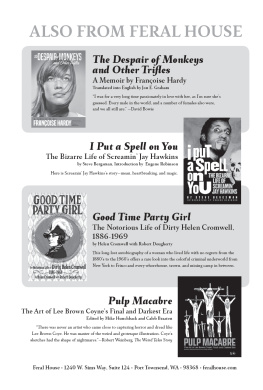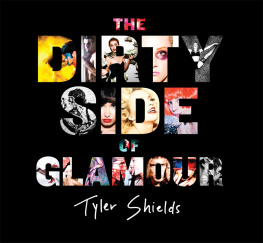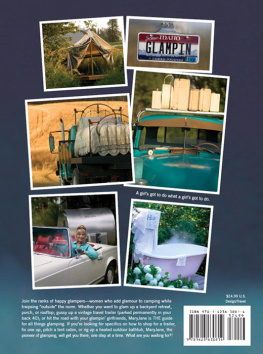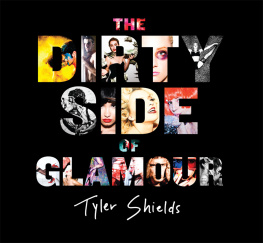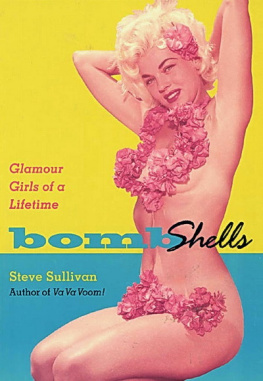ACKNOWLEDGMENTS
A s someone attracted to the nitty-gritty details of commerce and culture, with more interest in the complexities of clothing fit than the latest runway fashion, I never expected to write anything, let alone a book, on glamour. Despite what you might infer from its title, my 2003 book The Substance of Style was about the rise and nature of aesthetic value in such previously unstylish realms as toilet brushes and business-hotel rooms. It had nothing to do with glamour.
A year after it came out, however, Joe Rosa, then the architecture and design curator at the San Francisco Museum of Modern Art, asked me to write the introductory essay for the catalogue accompanying an exhibit on glamour in fashion, industrial design, and architecture. Knowing next to nothing about glamour (including what Joe meant by the term), I agreed. The more I thought and read about the subject, and the more I contemplated glamorous objects, the more fascinated I became. Analyzing glamour appealed to my interest in artifice, in persuasion, in history, in beauty, and in commercial culture. My ideas have evolved a lot since that first essay (and the 2004 TED talk drawn from it), but I owe Joe and his SFMOMA colleagues Karen Levine and Greg Sandoval a big thanks for starting me on a fascinating journey. Thanks also to Chris Anderson of TED.
Before and after I embarked on the book, editors at a number of publications gave me the opportunity to develop glamour-related ideas in articles. Im grateful to Meghan ORourke and Hanna Rosin at Slate , Claudia Payne at the New York Times , Rod Dreher at Big Questions Online , Gary Rosen and Ryan Sager at The Wall Street Journal , Phil Terzian at The Weekly Standard , Sarah Van Boven at Allure , and Ted Balaker and Nick Gillespie at Reason.tv. Robert Messenger, James Gibney, and James Bennet at The Atlantic deserve special thanks for indulging my interest in glamour, as do my wonderful current editors at Bloomberg View , Toby Harshaw and David Shipley.
Over the five years I worked on this book, many friends answered questions or sent me article links and other leads. With the growth of social media, their numbers have grown too great to track everyone by name. You all have my gratitude. I do want to particularly thank David B. Bernstein, Karlyn Bowman, Brian Chase, Christian Esquevin, Jacque Lynn Foltyn, Mike Godwin, Keating Holland, Grant McCracken, Adam Minter, Matt Novak, Charles Oliver, and Barry Strauss for their suggestions and help. I also enjoyed more formal research assistance from Bryan Castaeda, Dorian Electra, Crystal Hubbard, Herschel Nachlis, Paige Phelps, and Sara Dabney Tisdale.
I owe especially fervent research thanks to Autumn Whitefield-Madrano for retrieving the original Mademoiselle makeover articles from the New York Public Library and to Leslie Watkins for copying Lois Arderys Inarticulate Longings article from the J. Walter Thompson archives at Duke. James Sanders, whose brilliant Celluloid Skyline is a model of integrating history, culture, and imagery, gave me important early encouragement, as did Michael Bierut, who introduced me to James. The book also benefited greatly from two resources that werent available when I was researching my previous books: WorldCat.org, which provides a central hub for library catalogues, and Google Books, which identified, and in some cases unlocked, all sorts of hidden treasures. While I used many libraries in researching this book, Im especially grateful to the Santa Monica Public Library for its magnificent, open-stacks collection of bound magazine volumes.
Liberty Fund, whose conferences constitute the major part of my formal postcollegiate education, supported a conference on luxury whose readings helped inform my thinking about glamour. Amity Shlaes persuaded me to enter my articles for the 2011 Bastiat Prize, the funds from which allowed me to rent a desert cabin as a writers retreat while completing the manuscript. Before that, Bill and Karen Inman generously allowed me to use their vacation home for some valuable weeks of intense work. Joan Kron gave me moral support, access to her fantastic library, referral to many relevant articles from decades past, and many delightful nights of hospitality in her beautiful New York apartment.
In 2009 my friend Kate Coe and I started a group blog called Deep Glamour , allowing me to develop some of my own ideas, interview interesting people, and learn from my co-bloggers posts. I want to thank all the Deep Glamour bloggersKate Coe, Randall Shinn, Jessica Barber, Doug Champion, Albina Colden, Ingrid Fetell, Christine Hall, Raquel Laneri, Paige Phelps, Kit Pollard, Diego Rodriquez, and Cosmo Wenmanas well as everyone who has shared thoughts in interviews, comments, or guest posts.
Another valuable adventure has been teaching a short seminar on glamour in the masters in branding program at the School of Visual Arts. Thanks to Debbie Millman for enticing me to join the faculty, to Katie Scott and Jaime Cohen for administrative support, and to my students, especially Brian Gaffney, a star in the 2011 class and my teaching assistant in 2012.
I benefited from comments on early chapter drafts from Ed Brenegar, Sue Inman, Sally Satel, Randall Shinn, and Sara Dabney Tisdale. Later in the process, Chuck Freund, Nancy Hass, Joan Kron, Howard Miller, Sarah Skwire, and Viviana Zelizer gave me valuable feedback. Deirdre McCloskey, Jonathan Rauch, and Bob Roe provided crucial insights into the strengths and weaknesses of my first complete draft. Leslie Watkins, who may very well be my ideal reader, commented on multiple versions of the completed manuscript.
Gathering the photos for the book was a monumental job. Tim Rogers and Saundra Groves of D Magazine helped me obtain the Metropolitan ad in the first chapter, while Laura Thomas at SHVO helped me with Rector Square. Lou DElia and Mike Salazar generously provided first-rate scans of the George Hurrell photos. Jeff Wendt was a huge help, both in his professional role at the Everett Collection (where his colleague Marci Brennan was also a delight) and as a friend retouching images from my own collection and the Library of Congress. Joan Kron, Kate Hahn, and Sally Satel helped me to decide which photos to keep.
Over the long course of its development, the book had many editors. Amber Qureshi brought it to Free Press, where it was successively nurtured by Hilary Redmon and Alessandra Bastagli. I also received comments on the manuscript from Daniella Wexler. Jon Karp eventually moved it to Simon & Schuster, with a much-appreciated commitment to publish it in the beautiful form you now see. As my primary final editor, Emily Graff offered enthusiastic and perceptive feedback, with a youthful perspective that was particularly valuable. Im grateful to Marysue Rucci for her support and enthusiasm in bringing it to press, to Andrea DeWerd for her marketing savvy, to Peg Haller for copyediting and fact-checking that saved me from embarrassing errors, and to Nancy Singer for the beautiful design. Judy Kip, my go-to indexer since The Future and Its Enemies , did her usual excellent job. Jennifer George, Joy McCann, and Leslie Watkins supplemented my proofreading. Thanks to Jennifer Garza and especially Jessica Lawrence for publicity, and to my friend Susan Self for supplementing the S&S teams efforts.
My agent, Sarah Chalfant, has my eternal gratitude for her patience, persistence, and professionalism. She always believed in this project and was a cool head during many difficult moments.
My brilliant and beloved husband, Steven Postrel, was also enthusiastic from the start, and we had many fun and stimulating conversations sharing new examples and hammering out specific analytical points. He also read the manuscript countless times, providing tough, insightful criticism that, while not always well received, invariably turned out to be exactly right. I appreciate his willingness to spot contradictions and ask probing questions, despite the predictably unpleasant reaction, as much as I do his endless support and encouragement. Hes the best.

